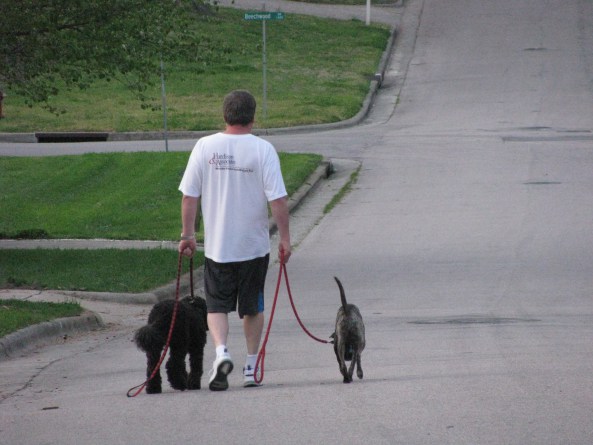
Having multiple dogs can be a rewarding (and therapeutic!) thing when you have peace in your pack. Issues can arise when you have dogs who are bossy or competing to be leader, especially when you yourself aren’t assuming the position. Without a doubt, humans are the leaders of the pack, allowing our dogs to relax, sit back, and follow our rules. Here are a few pointers on maintaining that leadership role to keep a happy household of dogs.
1. Always maintain a calm, confident, and assertive attitude. If you are freaking out and worrying about your dogs going after each other, stressing over how your relationship will be, then all you will have is a stressed out pack of dogs who are snappy with each other. Dogs feed off of our emotions, so always project confidence.
2. Regular exercise is vital for burning off energy. If your dogs get along great and you use playtime for them to exercise, that’s great! But don’t allow playtime to substitute for a walk. Walking as a confident leader (relaxed and in front with dogs loosely beside or behind) shows the dogs who they are supposed to follow and gets their brains concentrating on you.
3. Have your dogs respect thresholds. Practice by having everyone sit at the doorway. If you have lots of dogs, especially big ones, you can always just have them wait at the door before you call them through. Whichever dog is pushiest should come through that doorway last. Reward good, calm behavior. This will help your most demanding dog see that things happen faster when they are calm. Not rushing the door shows that you control all space, coming and going, and prevents a pack of dogs from hurdling past, through, and over you.
4. Balance your attention and affection. You may have a great pack of dogs, but don’t forget to treat them as individuals. Find the things that each dog enjoys most and then make time for that. For attention, make sure nobody is pushing anyone else out of the way. Spend time with one pup and then on your terms, call the next one over to you. Always show them that you dole out the affection on your terms and never reward a demanding, bossy dog.
5. Be involved in playtime! A rumbly tumbly pack can be having a wonderful time before Fluffy chomps Fido’s ear a bit too hard and then everyone joins in for a brawl. Get your dogs used to your presence between them, bump around while they’re playing happily and practice calling everyone, separating them, maybe have them sit, and then release them to play again. You can do this many times throughout playtime, always supervising and splitting them up when they’re still having a great time. This keeps them focusing on you, keeps playtime fun, and makes recall a part of play so it’s always fun to come to you!
6. Don’t let your dogs guard anything. As the leader, you are the only one who is allowed to protect anything – food, bones, toys, etc. Supervise feeding times and don’t let anyone steal from anyone else’s bowl. This lets everybody know that you are going to stick up for them and keep the peace. If a dog gets growly over a bone, claim the object by stepping on it and backing the dog away, and then they lose that bone. Be the mama dog and let the other dogs know you are keeping everything even.
7. Another great way to maintain calm is by having everybody sit for their dinner. If your dogs haven’t mastered this, you can practice sit for dinner one at a time before you graduate to everyone sitting before being released. Sitting for dinner is showing that you control mealtimes and that it’s no time for wild and crazy play. Like the doorway, the calmest dog gets to eat first.
Kersti Nieto
Certified Dog Trainer
K9 Solutions LLC
http://www.nck9solutions.com

